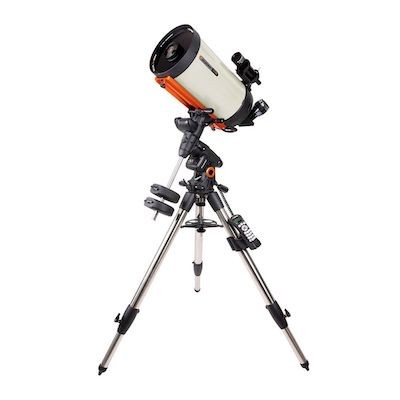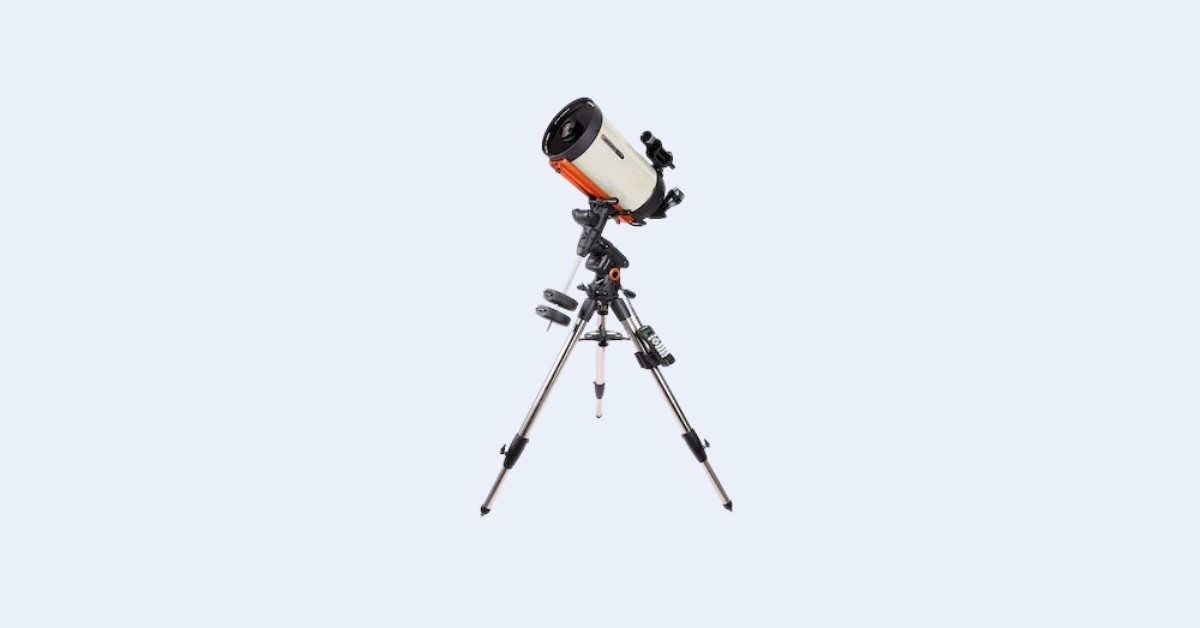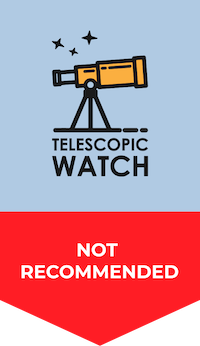The EdgeHD 9.25 Optical Tube
The Advanced VX 9.25” EdgeHD utilizes the Celestron 9.25” EdgeHD optical tube, a 9.25” (235mm) f/10 aplanatic Schmidt-Cassegrain telescope with a focal length of 2350mm, which can be brought down to 1650mm and f/7 with Celestron’s new, dedicated EdgeHD 9.25 reducer, or to an f/2, 470mm focal length system with a Starizona HyperStar kit.

The EdgeHD telescopes are aplanatic Schmidt-Cassegrain telescopes that use corrector lenses mounted in the baffle tubes within the telescope tube to correct for the regular Schmidt-Cassegrain optical design’s field curvature and mild coma, which are otherwise problematic when used for astrophotography, particularly with larger-format camera sensors. This design is similar to the Meade ACF system, but the Celestron EdgeHD telescopes are better supported by the company and third parties offering accessories such as the Starizona HyperStar f/2 conversion. The C9.25 is a little different in exact optical specs from the other Celestron SCT/EdgeHD configurations due to the weaker curvatures of both the primary and secondary mirrors, which make for a longer tube but easier manufacturing, collimation, and focusing tolerances, producing slightly sharper images. This is also why the 0.7x focal reducer for the EdgeHD 9.25 took time to design and only appeared on the market relatively recently.
In my observations, the EdgeHD 9.25’s main benefit for visual observation is its baffle tube diameter, as the normal C8 XLT vignettes with some low-power 2” eyepieces. The C9.25 XLT and EdgeHD 9.25, on the other hand, cover the same illuminated field, and as such, you are unlikely to notice any difference between the two when looking through one, as the field flattening and other optical corrections from the EdgeHD design are hardly of any significance with an eyepiece. Similarly, for planetary astrophotography, neither the illuminated field size nor the edge of field correction really matter. This strikes a blow at any advantage in buying the EdgeHD 9.25 over the C9.25 XLT for non-imaging applications.
The EdgeHD 9.25’s focus is adjusted by turning a knob at the back of the scope to move the primary mirror inside the tube. This is the same design as most catadioptric telescopes use. To prevent “mirror flop” issues during long exposures from the mirror wobbling on its support, the EdgeHD 9.25 has locking knobs that you engage once you’ve reached focus with your camera. For visual use, this is an irrelevant feature. The back of the scope has standard SCT threads for attaching any necessary adapters or accessories.
The EdgeHD 9.25 also has rear vents with HEPA-grade filters to help it cool down a little faster, and a built-in carrying handle at the back of the tube for portability (which you may want to remove as it can make getting the scope on the mount more difficult). These vents prevent pollen, dust, and other debris from contaminating the optics, and the handle makes it easier to transport the telescope.
To collimate the C9.25 EdgeHD, you need to adjust the three small Philips head screws on the secondary mirror, which is rarely required. Our collimation guide goes into further detail. The EdgeHD 9.25 has a CGE-style dovetail for attaching to an equatorial mount such as the Advanced VX, with threaded holes at the top of the tube to attach a second plate for piggybacking a guide scope or other astrophotography accessories as needed.
Accessories
The Advanced VX 9.25” EdgeHD includes a 2” screw-on dielectric mirror star diagonal with a 1.25” adapter that works well for visual use, as well as a single 2” 23mm Celestron Luminos medium-power eyepiece (102x). The 23mm Celestron Luminos features a twist-up eyecup and an 82-degree apparent field of view. When used with the EdgeHD 9.25 at its native focal length, the 23mm Luminos produces a true field of approximately 0.8 degrees, or slightly more than 1.5 times the full moon’s angular diameter. This is close to the limit of what you can achieve with the telescope at low power, and the 82-degree apparent field is quite immersive. Higher magnifications can be achieved with the purchase of additional eyepieces.
The Advanced VX 9.25” EdgeHD includes Celestron’s standard kit 9×50 straight-through finderscope with an upside-down view and a true field of about 5 degrees. This finder allows you to see stars and deep-sky objects that are fainter than you can see with your naked eye, though this isn’t necessary for the task of merely aligning a GoTo mount. The light-gathering power of the finder may be unnecessary, but its magnification and crosshairs make it easier to center stars for alignment, which can expedite setup for visual use. You don’t need it for deep-sky astrophotography, as it is little more than extra dead weight when you plate solve in lieu of a star alignment.
The Advanced VX Equatorial Mount
The Celestron Advanced VX is the smallest, lightest, and least capable of the company’s computerized German equatorial mounts. Like most Celestron mounts, the Advanced VX uses the NexStar+ hand controller and is compatible with Celestron’s family of accessories, like the StarSense AutoAlign, SkySync GPS, and SkyPortal WiFi adapter.
The dovetail saddle provided by default with the Advanced VX can accommodate the EdgeHD 9.25’s CGE dovetail bar as well as smaller Vixen-style bars, but not Losmandy D-style bars, due to its simple set screw clamping mechanism, which is not sufficiently wide for regular Losmandy plates. The Advanced VX has a weight capacity of 30 lbs, making it just barely suitable for short exposure/planetary imaging and visual use with the EdgeHD 9.25, which weighs 21 lbs by itself and is about 25 lbs by the time you add the provided star diagonal, eyepiece, finder, and dew shield to it. If you were to use a heavy camera, guide scope, and autoguider, you could exceed that load and even reach 30 lbs. This easily violates the accepted standard of not exceeding half the stated weight capacity of a mount for deep-sky imaging, and the 1650mm focal length of the EdgeHD 9.25 with an f/7 reducer requires extremely accurate tracking and autoguiding tolerances to avoid blurry and trailed images, even with fairly short exposures. The cheap servo motors and low-quality bearings in the Advanced VX do not help, nor do the incompatibility with EQMOD and your reliance on the ST-4 autoguider port for autoguiding.
For visual use, the Advanced VX is sufficient, albeit barely, for holding the EdgeHD 9.25, requiring both of the provided 11 lb counterweights to be mounted nearly all the way down the counterweight shaft to balance. After polar alignment with either a polar scope or Celestron’s All-Star Polar Align tool, you just align the Advanced VX on a few bright stars and confirm their location in the eyepiece, after which it will slew to and track anything you select from its 40,000 object database. The weight of the EdgeHD 9.25 means you’ll probably need to utilize the mount’s “Sync” function frequently to compensate for errors in the GoTo mechanism’s accuracy.
Should I buy a Used Celestron Advanced VX 9.25″ EdgeHD?
A used Advanced VX 9.25” EdgeHD can be a good option, but the same considerations for deep-sky imaging capabilities (or lack thereof) apply, and you should really only bother if it’s cheaper than a standard C9.25 XLT and/or you plan on using the EdgeHD 9.25 on a better mount. As always, check that the mount powers on and tracks (if possible) and avoid purchasing a scope with any damage to the optics; a broken corrector plate cannot be replaced, and any issues inside the telescope will require it to be sent to Celestron for repairs due to the complex internal optics and parts of the EdgeHD design.
Alternative Recommendations
The Advanced VX 9.25” EdgeHD is, as mentioned, a pretty terrible pick for almost any application you can think of due to its limitations and cost. In its place, we would recommend a 10-12” Dobsonian, the Celestron Advanced VX 9.25” XLT Schmidt-Cassegrain, or choosing your own suitable telescope/mount combination for imaging.
Aftermarket Accessory Recommendations
A dew shield is necessary for any Schmidt-Cassegrain telescope like the EdgeHD 9.25 to keep dew from fogging your view or chemically damaging the Schmidt corrector plate and its StarBright XLT coatings. It also helps to reduce glare and reflections much like a lens shade, as well as prevent any accidental fingerprints from getting on the corrector. You may want a heated unit if you live in a very wet climate.
The stock 23mm Luminos eyepiece is great when used with the EdgeHD 9.25, but at the minimum you’ll want one additional eyepiece for higher power, such as the Explore Scientific 8.5mm 82-degree (276x) or a 9mm redline/goldline (261x). A UHC filter, such as the 2” Orion UltraBlock, screws onto your eyepiece or a 1.25” adapter and enhances contrast when viewing nebulae.
You’ll also need a polar scope to assist in aligning the Advanced VX if you don’t want to use the All-Star Polar Align, and either an AC adapter or a suitable power supply to power it for extended periods, like the Celestron PowerTank Lithium Pro.
What can you see?
Compared to an 8” Schmidt-Cassegrain, EdgeHD, or Dobsonian, the EdgeHD 9.25 has about 33% more light gathering ability—just enough to notice a difference in brightness at the eyepiece—and 16% more resolution, though the latter spec is not exactly a fair comparison as the C9.25 and EdgeHD 9.25 perform slightly better due to their different optical designs from most other comparable catadioptric telescopes.
The EdgeHD 9.25’s limited field of view (under 1 degree maximum, or 0.8 degrees with the provided 23mm Luminos) limits its capability for viewing large deep-sky objects such as emission nebulae or open clusters, though smaller open clusters like M11 or M38 still look nice, and globular star clusters like M13 or M15 can be easily resolved at the 102x provided by the stock 23mm Luminos eyepiece. Planetary nebulae reveal colorful forms and fine detail at high magnifications on a steady night with the EdgeHD 9.25, and emission nebulae like Orion (M42), the Swan (M17), and the Lagoon (M8) look great with the EdgeHD 9.25 with dark skies and/or a UHC filter to improve contrast.
The EdgeHD 9.25 is a great telescope for observing galaxies, especially when used in a location with dark skies (though larger aperture scopes will, as always, beat it). The EdgeHD 9.25 is capable of resolving details such as H-II regions and dust lanes in many of the brightest galaxies like Andromeda (M31) and M82, as well as somewhat resolving the spiral arms in galaxies like M51. There are also plenty of galaxy groups and clusters to go after, with the total number of galaxies visible with the EdgeHD 9.25 being in the tens of thousands under a dark sky.
The EdgeHD 9.25 is also excellent for observing the Moon and planets, with the slight depth-of-field, optical quality, and collimation advantages providing more of a performance boost over a regular 8” SCT than the mere 16% increase in linear resolution might suggest. It can show the phases of Venus and Mercury, as well as features on Mars, such as dark markings and polar ice caps. The Moon looks fantastic, with the EdgeHD 9.25 showing you details such as craterlets and tiny ridges that can be less than a mile across. Jupiter’s atmospheric details, such as the Great Red Spot, cloud bands, and smaller festoons or storms, can be viewed, along with the disks of its four large Galilean moons, which begin to reveal tiny, if mostly unresolved, surface details themselves. You can also resolve the Cassini Division and occasionally the Encke Gap in Saturn’s rings alongside the gas giant’s cloud banding and a few moons. Uranus’ turquoise disk is distinctly resolved, and at least one or two moons can be seen under dark skies with steady seeing. Neptune is barely resolved on a good night with the EdgeHD 9.25 alongside its moon Triton, and Pluto can be observed under dark skies if you know where to look, though it is getting dimmer and harder to view each year as it gets further from the Sun.
Astrophotography Capabilities
Deep-sky astrophotography with the Advanced VX 9.25” EdgeHD is a futile effort. You of course need an f/7 reducer with any of the EdgeHD telescopes for deep-sky imaging, but even at f/7 with autoguiding and accurate polar alignment, you cannot achieve a long enough exposure for good data before the Advanced VX’s tracking errors blur your images with the EdgeHD 9.25.
The EdgeHD 9.25 has little benefit over the regular C9.25 XLT for planetary astrophotography; the mirror locks and vents are a fringe bonus at best. However, like the C9.25 XLT, you can get excellent shots of the Moon and planets with a 2-3x Barlow and a good planetary camera such as the ZWO ASI224MC or other high-speed, high-resolution, and small-pixel planetary/guide cameras.



